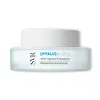What's inside
What's inside
 Key Ingredients
Key Ingredients

 Benefits
Benefits

 Concerns
Concerns

 Ingredients Side-by-side
Ingredients Side-by-side

Water
Skin ConditioningGlycerin
HumectantCaprylic/Capric Triglyceride
MaskingDipropylene Glycol
HumectantPolyglyceryl-3 Distearate
EmulsifyingPentaerythrityl Tetraethylhexanoate
Emollient1,2-Hexanediol
Skin ConditioningDiphenyl Dimethicone
EmollientMethyl Trimethicone
Skin ConditioningPentylene Glycol
Skin ConditioningVinyldimethicone
Cetearyl Alcohol
EmollientBehenyl Alcohol
EmollientCetyl Alcohol
EmollientPolymethylsilsesquioxane
Hydroxyethyl Acrylate/Sodium Acryloyldimethyl Taurate Copolymer
Emulsion StabilisingChlorella Vulgaris Extract
Skin ConditioningGlucose
HumectantPolyglyceryl-2 Stearate
EmulsifyingButylene Glycol
HumectantFructooligosaccharides
HumectantFructose
HumectantHydroxyacetophenone
AntioxidantSodium Stearoyl Glutamate
CleansingGlyceryl Stearate
EmollientCarbomer
Emulsion StabilisingStearyl Alcohol
EmollientGlyceryl Stearate Citrate
EmollientTromethamine
BufferingButyrospermum Parkii Butter
Skin ConditioningCocos Nucifera Oil
MaskingLactobacillus
Skin ConditioningHelianthus Annuus Seed Oil
EmollientEthylhexylglycerin
Skin ConditioningSodium Phytate
Xanthan Gum
EmulsifyingSorbitan Isostearate
EmulsifyingBifida Ferment Lysate
Skin ConditioningPelargonium Graveolens Flower Oil
MaskingCitrus Aurantium Dulcis Peel Oil
MaskingMelia Azadirachta Flower Extract
Skin ConditioningCananga Odorata Flower Oil
MaskingCitrus Aurantium Bergamia Fruit Oil
MaskingMelia Azadirachta Leaf Extract
Skin ConditioningCurcuma Longa Root Extract
MaskingOcimum Sanctum Leaf Extract
Skin ConditioningRosa Damascena Flower Oil
MaskingCorallina Officinalis Extract
Skin ConditioningTocopherol
AntioxidantWater, Glycerin, Caprylic/Capric Triglyceride, Dipropylene Glycol, Polyglyceryl-3 Distearate, Pentaerythrityl Tetraethylhexanoate, 1,2-Hexanediol, Diphenyl Dimethicone, Methyl Trimethicone, Pentylene Glycol, Vinyldimethicone, Cetearyl Alcohol, Behenyl Alcohol, Cetyl Alcohol, Polymethylsilsesquioxane, Hydroxyethyl Acrylate/Sodium Acryloyldimethyl Taurate Copolymer, Chlorella Vulgaris Extract, Glucose, Polyglyceryl-2 Stearate, Butylene Glycol, Fructooligosaccharides, Fructose, Hydroxyacetophenone, Sodium Stearoyl Glutamate, Glyceryl Stearate, Carbomer, Stearyl Alcohol, Glyceryl Stearate Citrate, Tromethamine, Butyrospermum Parkii Butter, Cocos Nucifera Oil, Lactobacillus, Helianthus Annuus Seed Oil, Ethylhexylglycerin, Sodium Phytate, Xanthan Gum, Sorbitan Isostearate, Bifida Ferment Lysate, Pelargonium Graveolens Flower Oil, Citrus Aurantium Dulcis Peel Oil, Melia Azadirachta Flower Extract, Cananga Odorata Flower Oil, Citrus Aurantium Bergamia Fruit Oil, Melia Azadirachta Leaf Extract, Curcuma Longa Root Extract, Ocimum Sanctum Leaf Extract, Rosa Damascena Flower Oil, Corallina Officinalis Extract, Tocopherol
Water
Skin ConditioningButylene Glycol
HumectantGlycerin
HumectantPropylene Glycol
HumectantCaprylic/Capric Triglyceride
MaskingAscorbyl Tetraisopalmitate
Antioxidant1,2-Hexanediol
Skin ConditioningC10-18 Triglycerides
EmollientCarbomer
Emulsion StabilisingMaltodextrin
AbsorbentSodium Hyaluronate
HumectantSodium Acrylates Copolymer
Acrylates/C10-30 Alkyl Acrylate Crosspolymer
Emulsion StabilisingCaprylyl Glycol
EmollientParfum
MaskingSodium Hydroxide
BufferingLecithin
EmollientLactobacillus Ferment
Skin ConditioningPentaerythrityl Tetra-Di-T-Butyl Hydroxyhydrocinnamate
AntioxidantSodium Acetylated Hyaluronate
HumectantWater, Butylene Glycol, Glycerin, Propylene Glycol, Caprylic/Capric Triglyceride, Ascorbyl Tetraisopalmitate, 1,2-Hexanediol, C10-18 Triglycerides, Carbomer, Maltodextrin, Sodium Hyaluronate, Sodium Acrylates Copolymer, Acrylates/C10-30 Alkyl Acrylate Crosspolymer, Caprylyl Glycol, Parfum, Sodium Hydroxide, Lecithin, Lactobacillus Ferment, Pentaerythrityl Tetra-Di-T-Butyl Hydroxyhydrocinnamate, Sodium Acetylated Hyaluronate
Ingredients Explained
These ingredients are found in both products.
Ingredients higher up in an ingredient list are typically present in a larger amount.
1,2-Hexanediol is a synthetic liquid and another multi-functional powerhouse.
It is a:
- Humectant, drawing moisture into the skin
- Emollient, helping to soften skin
- Solvent, dispersing and stabilizing formulas
- Preservative booster, enhancing the antimicrobial activity of other preservatives
Butylene Glycol (or BG) is used within cosmetic products for a few different reasons:
Overall, Butylene Glycol is a safe and well-rounded ingredient that works well with other ingredients.
Though this ingredient works well with most skin types, some people with sensitive skin may experience a reaction such as allergic rashes, closed comedones, or itchiness.
Learn more about Butylene GlycolThis ingredient is an emollient, solvent, and texture enhancer. It is considered a skin-softener by helping the skin prevent moisture loss.
It helps thicken a product's formula and makes it easier to spread by dissolving clumping compounds.
Caprylic Triglyceride is made by combining glycerin with coconut oil, forming a clear liquid.
While there is an assumption Caprylic Triglyceride can clog pores due to it being derived from coconut oil, there is no research supporting this.
Learn more about Caprylic/Capric TriglycerideCarbomer is a polymer of acrylic acid. Its main role is to create a gel consistency.
A high amount of carbomer can cause pilling or balling up of products. Don't worry, most products contain 1% or less of carbomer.
Glycerin is already naturally found in your skin. It helps moisturize and protect your skin.
A study from 2016 found glycerin to be more effective as a humectant than AHAs and hyaluronic acid.
As a humectant, it helps the skin stay hydrated by pulling moisture to your skin. The low molecular weight of glycerin allows it to pull moisture into the deeper layers of your skin.
Hydrated skin improves your skin barrier; Your skin barrier helps protect against irritants and bacteria.
Glycerin has also been found to have antimicrobial and antiviral properties. Due to these properties, glycerin is often used in wound and burn treatments.
In cosmetics, glycerin is usually derived from plants such as soybean or palm. However, it can also be sourced from animals, such as tallow or animal fat.
This ingredient is organic, colorless, odorless, and non-toxic.
Glycerin is the name for this ingredient in American English. British English uses Glycerol/Glycerine.
Learn more about GlycerinWater. It's the most common cosmetic ingredient of all. You'll usually see it at the top of ingredient lists, meaning that it makes up the largest part of the product.
So why is it so popular? Water most often acts as a solvent - this means that it helps dissolve other ingredients into the formulation.
You'll also recognize water as that liquid we all need to stay alive. If you see this, drink a glass of water. Stay hydrated!
Learn more about Water